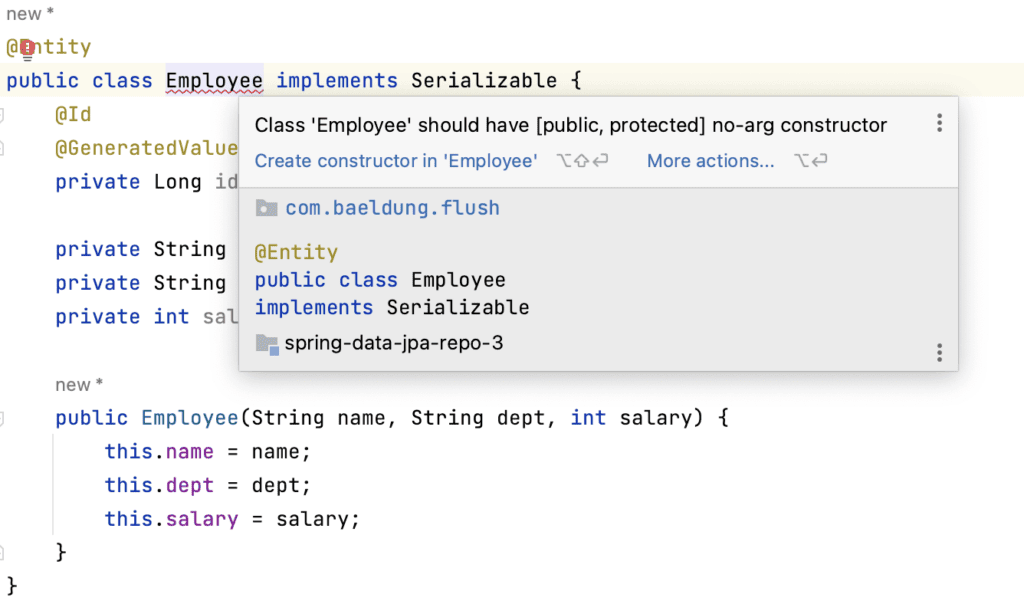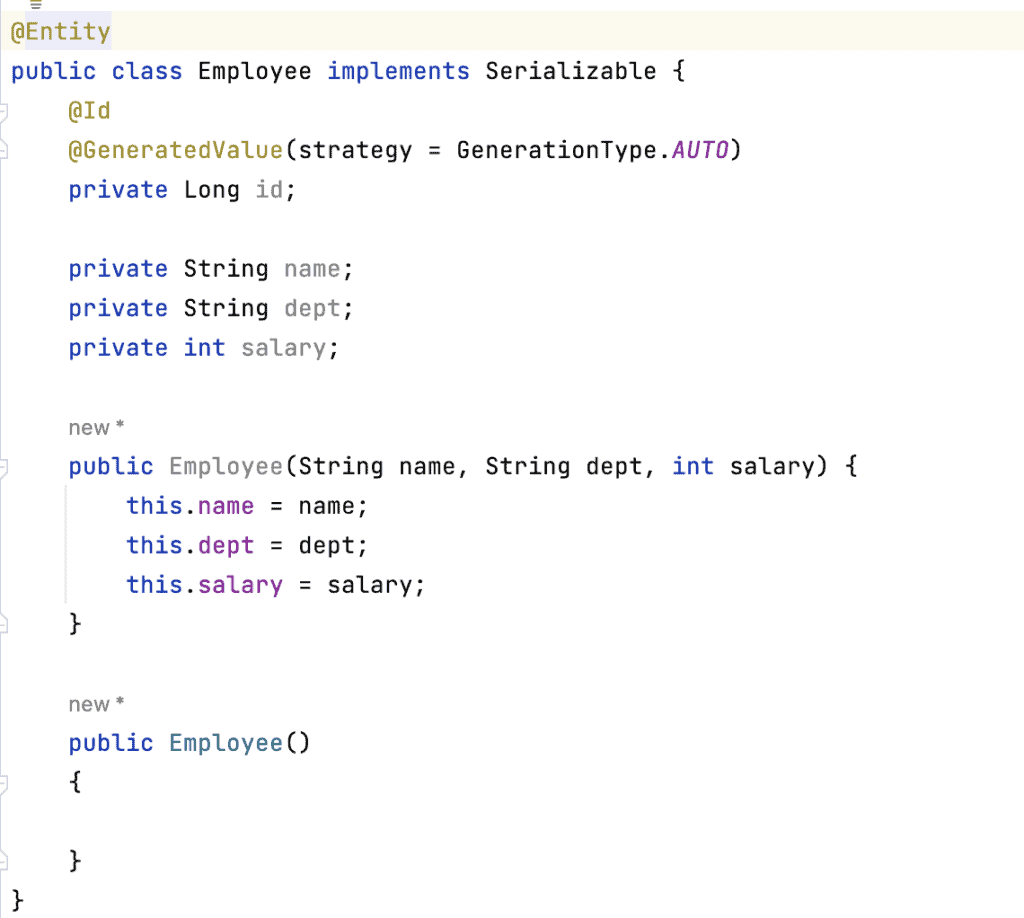1. Overview
In this quick tutorial, we’ll learn about the JPA requirement for a default no-argument constructor in an Entity class.
To understand the significance of a no-argument constructor, we’ll use a simple example of an Employee entity. We’ll observe how the absence of a default constructor leads to a compile-time error. We’ll delve into the use of Reflection by JPA for entity instantiation. Additionally, we’ll briefly touch upon some other reasons why this constructor might be required in these classes.
2. Example Setup
Let’s set up a simple example of an entity class called Employee with the name, department, and auto-generated id. Let’s define a constructor that takes all three fields:
@Entity
public class Employee {
@Id
private Long id;
private String name;
private int age;
public Employee(Long id, String name, int age) {
this.id = id;
this.name = name;
this.age = age;
}
// getters and setters
}
However, at this point, we’ll notice that the Employee class won’t compile:

Clearly, here we can see that we have defined an Entity class with a parametrized constructor, but there’s no no-argument constructor. In this case, there’s a compile-time error which suggests we need a no-arg constructor in addition to the existing one.
In the next two sections, we’ll look at the JPA specification around the constructor in the Entity class. We’ll see how we can fix the error and the underlying reasons why these constraints are imposed by JPA.
3. JPA Specification, Constructors, and Reflection
The JPA specification requires all Entity classes to have a default no-arg constructor. This can be either public or protected.
If no other constructor is defined, a default no-arg constructor will be provided automatically at compile time. However, if we’ve defined a parameterised constructor, we must also provide a default constructor explicitly.
This default constructor is used by JPA to create instances of the entity class using Reflection. It provides a way to dynamically create instances of classes, call methods, and access fields.
To create an instance of a class using Reflection, we can use the Class class and its newInstance() method. When JPA creates an instance of a persistent entity class, it first obtains its Class object using the entity’s fully qualified class name. Once it has the Class object, JPA uses Reflection to create a new instance of the class by invoking the no-arg constructor. Therefore, providing a no-arg constructor in JPA entity classes is always a good practice, even if we don’t use it explicitly.
Simply put, to fix this issue, let’s explicitly define a no-arg constructor in the Employee entity class:
@Entity
public class Employee implements Serializable {
@Id
@GeneratedValue(strategy = GenerationType.AUTO)
private Long id;
private String name;
private String dept;
private int salary;
public Employee(String name, String dept, int salary) {
this.name = name;
this.dept = dept;
this.salary = salary;
}
public Employee() {
}
}
Now the compile-time error is fixed:

Evidently, the previous compiler error has been resolved now by introducing a no-argument constructor.
4. Reasons for No-Arg Constructor
Firstly, as we briefly discussed in the previous section, JPA implementations, such as Hibernate, use Reflection to create instances of entity classes. This allows dynamic class inspection and instantiation at runtime. To create an entity object, the JPA provider needs to invoke a constructor without any arguments. If a no-arg constructor isn’t present, it results in an exception during object instantiation.
Furthermore, JPA providers often employ proxy objects for performance optimization and lazy loading of relationships. Proxy objects are dynamically generated subclasses of entity classes. These subclasses require a no-arg constructor to create instances and fulfil their purpose. Without it, the proxy mechanism fails, leading to runtime errors.
Lastly, we know that JPA provides two-way mapping between entities and database tables. During the process of mapping entity objects to their corresponding database records, the JPA provider must create instances of entity classes. Without a no-arg constructor, the provider is unable to instantiate the entity objects, causing mapping failures and data retrieval issues.
5. Conclusion
In this article, we discussed the need for a default no-argument constructor in entity classes.
We learned that it enables JPA providers to instantiate objects, utilize proxy mechanisms, and perform seamless mapping between entities and database tables.
The lack of a no-arg constructor leads to compile-time errors, preventing the successful execution of persistence operations. By understanding the need for a no-arg constructor and the role of reflection in handling entity instantiation, we can ensure the smooth functioning of JPA-based applications.






